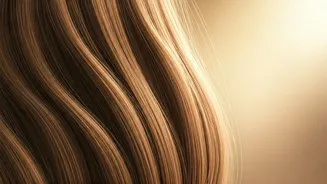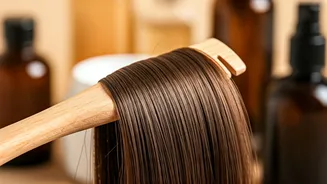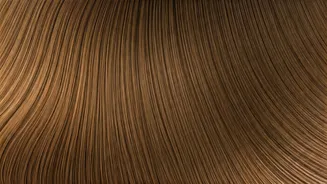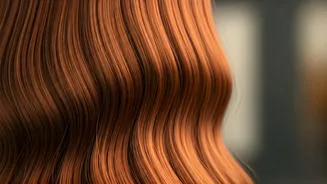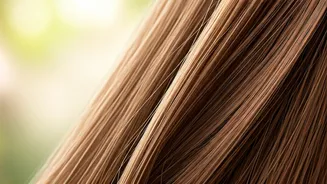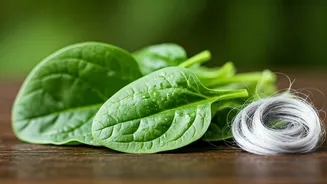Regular Trims Matter
Contrary to common belief, trimming your hair regularly can actually contribute to faster growth. This might sound counterintuitive, but trimming eliminates
split ends, which travel up the hair shaft, causing breakage. When split ends are removed, your hair is less prone to damage, allowing it to grow longer and healthier. Aim for a trim every 6-8 weeks, depending on your hair type and how quickly it grows. Consistent trimming keeps your hair in its best shape, reducing the need for more drastic cuts later. The removal of the damaged ends promotes better growth and reduces the overall fragility of the hair.
Stay Hydrated Daily
Hydration is essential for overall health, and hair growth is no exception. Drinking enough water supports all bodily functions, including those related to hair. When you're adequately hydrated, your hair follicles receive the nutrients they need to thrive. Dehydration can lead to dry, brittle hair that is prone to breakage. Aim to drink at least eight glasses of water per day, or more if you're active or live in a warm climate. You can also incorporate hydrating foods like fruits and vegetables into your diet to boost your water intake. Proper hydration ensures that your hair remains strong and flexible, facilitating better growth and reduced breakage.
Heat Styling: Avoid It
Heat styling tools like hair dryers, curling irons, and straighteners can cause significant damage to your hair. The high temperatures strip away moisture, making hair dry, weak, and prone to breakage. Repeated heat exposure can also damage the hair's protein structure, leading to split ends and slower growth. If you must use heat styling tools, always use a heat protectant spray. These products create a barrier between your hair and the heat, minimizing damage. Consider air-drying your hair whenever possible or using lower heat settings. Reducing heat exposure will drastically improve the health of your hair, leading to faster growth and improved texture.
Ditch Tight Hairstyles
Tight hairstyles, such as braids, ponytails, and buns, can put excessive strain on your hair follicles. This traction can lead to a condition called traction alopecia, where hair loss occurs due to repeated pulling. These hairstyles can also cause breakage, hindering growth. If you regularly wear tight hairstyles, make sure to give your hair a break by wearing looser styles. Opt for styles that allow your hair to move freely and avoid pulling on the roots. Using gentle hair ties and avoiding excessive tension will help protect your hair follicles and support healthy growth. Looser styles also distribute pressure, preventing damage and promoting better hair health.
Patience is Crucial
Hair growth is a gradual process, and patience is key. On average, hair grows about half an inch per month, which can vary depending on factors like genetics, health, and diet. Avoid getting discouraged if you don't see immediate results. Consistency with your hair care routine is crucial. Regularly trimming your hair, staying hydrated, avoiding heat styling, and eating a balanced diet will collectively contribute to noticeable improvements over time. Keep track of your progress, and celebrate the small victories. Recognizing your efforts and giving your hair time to flourish, is crucial for seeing the best results.
Prioritize Sleep Quality
Getting enough sleep is essential for overall health, and it also plays a significant role in hair growth. During sleep, your body repairs and regenerates cells, including those in your hair follicles. A lack of sleep can disrupt this process, potentially slowing down hair growth. Aim for 7-9 hours of quality sleep each night. Create a relaxing bedtime routine to help you fall asleep and stay asleep. This may include avoiding caffeine before bed, creating a comfortable sleep environment, and turning off electronic devices. Prioritizing sleep will benefit your hair's health and enhance its ability to grow longer and stronger.
Sun Protection Matters
Just like your skin, your hair needs protection from the sun's harmful UV rays. Prolonged sun exposure can damage the hair's protein structure, making it dry, brittle, and prone to breakage. This can hinder your hair growth efforts. When spending time outdoors, wear a hat, scarf, or use hair products with UV protection. These measures shield your hair from sun damage, helping it maintain its strength and elasticity. Limiting sun exposure and using protective products will help protect your hair from damage and encourage healthy growth. Protecting your hair from the sun helps maintain its strength and prevents damage.
Massage Scalp Regularly
Scalp massages can boost hair growth by stimulating blood flow to the hair follicles. Increased blood flow brings oxygen and nutrients to the follicles, supporting healthy hair growth. Regular scalp massages can also help to remove product buildup and unclog hair follicles, which is essential. You can massage your scalp with your fingertips in circular motions for a few minutes each day. Alternatively, you can use a scalp massager tool for a more thorough massage. This improves blood circulation. Incorporating this habit into your hair care routine will invigorate your scalp, promote hair growth, and contribute to overall hair health.
Eat Balanced Diet
A balanced diet provides the essential nutrients your body needs to support hair growth. Your hair follicles require a variety of vitamins, minerals, and proteins to function optimally. Incorporate foods rich in protein, such as lean meats, eggs, and legumes. Include omega-3 fatty acids, found in foods like salmon and flaxseeds, which can promote hair health. Ensure you're consuming enough vitamins and minerals, especially biotin, iron, and zinc, which are crucial for hair growth. A diet that is varied and includes a wide range of nutrient-rich foods will supply your hair follicles with the building blocks they need to thrive. Focus on a balanced diet rich in essential nutrients.
Be Consistent Always
Consistency is key to seeing results in any hair care routine. Implementing these tips consistently is more important than the specific methods. Develop a regular hair care routine that you can stick to over time. This includes regular trims, proper hydration, avoiding heat styling, and maintaining a balanced diet. Stay patient and persistent, even when results aren't immediately visible. It takes time for your hair to grow and for improvements to become apparent. A consistent approach will lead to noticeable improvements in your hair's health, promoting faster growth and a healthier appearance. Create a routine you can easily maintain.
